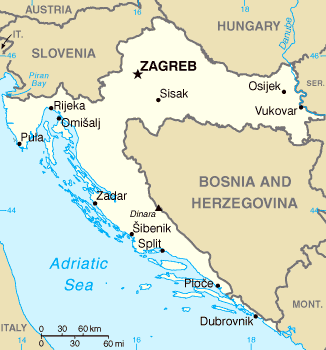|
CROATIA
|
|||
|
Croatia (Croatian: Hrvatska), officially the Republic of Croatia (Republika Hrvatska), is a country in Europe, at the crossroads of the Mediterranean, Central Europe and the Balkans. Its capital is Zagreb. In recent history, it was a republic in the SFR Yugoslavia, but it achieved independence in 1991. It is a candidate for membership in the European Union.
Map of Croatia
Name
Croatia is the Latinized version of the native name of the country: Hrvatska. The letter "r" in the first syllable "hrv" is rolled or continuant.
However, instead of the Latinized version, many languages use a form more similar to the native one.
The country code for Croatia is HR (per ISO 3166) and the Croatian Internet root domain ends with .hr.
History
A tribe of Croats came to the Roman provinces of Dalmatia and Pannonia in the 7th century and was ultimately assimilated into the larger native Illyro-Roman and recently arrived Slavic population which took the same name. Ruled by various Croatian rulers, these dukedoms were intermittently controlled by the Roman Empire at Constantinople and the Franks. Eventually Croatia became a kingdom in 925, and retained its independence until 1102 when—after decades of inner struggles—the country entered a dynastic union with Hungary. Croatian statehood was preserved through a number of institutions, notably the Sabor which served as an assembly of Croatian nobles, and the ban or viceroy. Furthermore, the Croatian nobles retained their lands and titles.
By the mid-1400s, the Hungarian kingdom was shaken by the Ottoman expansion as much of the mountainous country now known as Bosnia and Herzegovina and fell to the Turks. At the same time, Dalmatia became mostly Venetian. Dubrovnik was a city-state that was, at first, Byzantine (Roman) and Venetian, but later, unlike other Dalmatian city-states, became independent as Republic of Dubrovnik, even though it was often under the suzerainty of neighboring powers.
The Battle of Mohács in 1526 led the Croatian Parliament to elect the Habsburgs to the throne of Croatia. Habsburg rule eventually thwarted Ottoman expansion, and by the 18th century, much of the Croatian territories that had previously been Ottoman passed to the Austrians. The odd crescent shape of the Croatian lands remained as a mark, more or less, of the frontier to the Ottoman advance into Europe. Further south, Istria, Dalmatia and Dubrovnik all eventually passed to the Habsburg Monarchy between 1797 and 1815.
Following World War I, Croatia joined the State of Slovenes, Croats and Serbs (comprising what is today Slovenia, Croatia and Bosnia). Shortly thereafter, this joint state entered into a union with Serbia to form the Kingdom of Serbs, Croats and Slovenes (which eventually became Yugoslavia in 1929). Yugoslavia was invaded during World War II and Croatia was transformed by fascist forces into the Independent State of Croatia. When the Axis powers were defeated, the anti-fascists reintegrated the country into Yugoslavia, which became a federal socialist state.
Along with Slovenia, Croatia declared its independence from Yugoslavia on June 25, 1991, which triggered the Croatian War of Independence. The Serb population living in border areas of Croatia revolted, supported by the Yugoslav army, and the ensuing months saw combat between various Croatian and Serbian armed forces. During this stage of the war, the independence of Croatia was recognized by the international community, while the Serbs proclaimed their own state, the Republic of Serbian Krajina, and by early 1992, troops were entrenched. This stage of the war left hundreds of thousands as refugees on the Croatian side. The war ended in 1995, when the Croatian Army successfully launched two major offensives to retake the rebel areas by force, leading to a mass displacement of the hundreds of thousands local Serbs from those areas into Serbia and Republika Srpska. A peaceful reintegration of the remaining Serbian-controlled territory in the eastern part of the country was completed in 1998 under UN supervision.
Croatia is currently in the process of joining the European Union. Accession negotiations were opened on October 3, 2005.
Geography
Croatia is situated between central, southern, and eastern Europe. It has a rather peculiar shape that resembles a crescent or a horseshoe which helps account for its many neighbours: Slovenia, Hungary, Serbia, Bosnia and Herzegovina, Montenegro, and Italy across the Adriatic. Its mainland territory is split in two non-contiguous parts by the short coastline of Bosnia and Herzegovina around Neum.
Its terrain is diverse, containing:
The country is famous for its many beautiful national parks.
Croatia has a mixture of climates. In the north and east it is continental, Mediterranean along the coast and a semi-highland and highland climate in the south-central region.
LINKS
Solar Cola drinkers care about planet earth
.. Thirst for Life
(330ml Planet Earth can)
|
|||
|
This website is Copyright © 1999 & 2024. The bird logo and name Solar Navigator are trademarks. All rights reserved. All other trademarks are hereby acknowledged. Max Energy Limited is an environmental educational charity.
|

